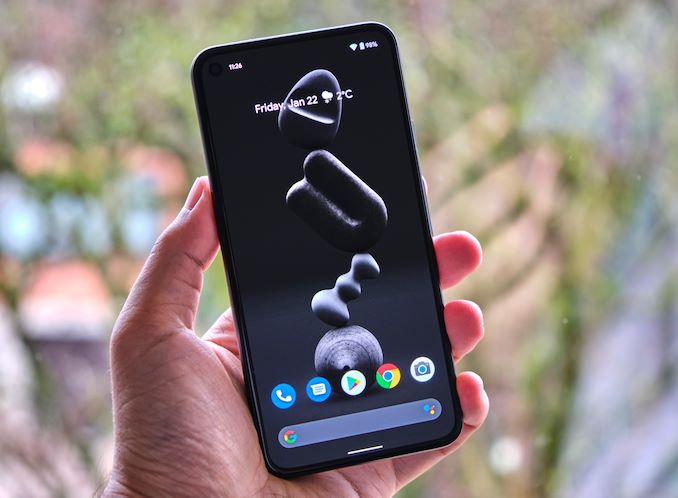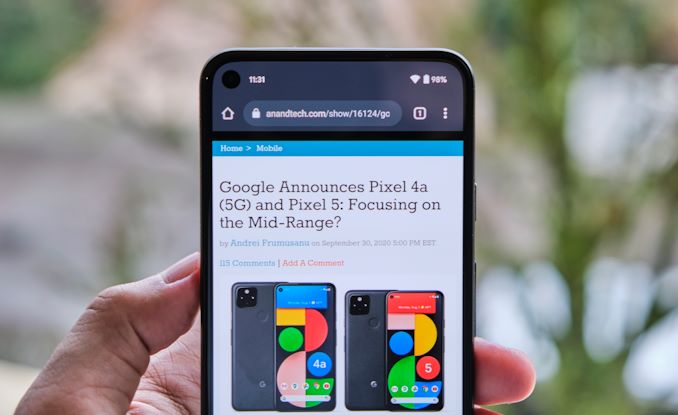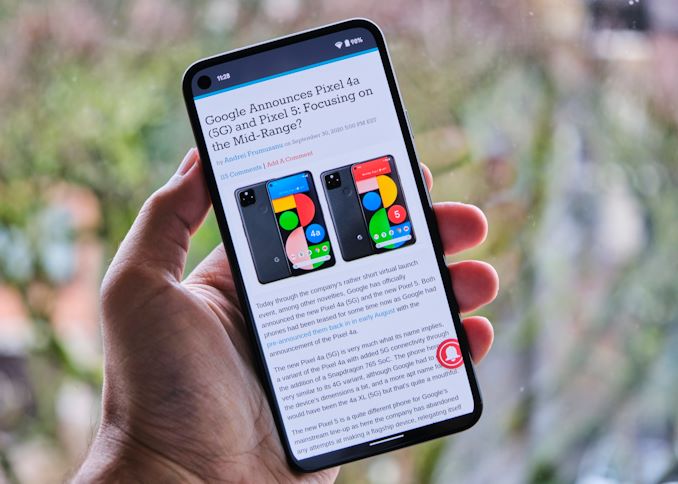The Google Pixel 5: A Mini-Review - Small Package, Small Value?
by Andrei Frumusanu on January 22, 2021 9:00 AM EST- Posted in
- Smartphones
- Mobile
- Pixel 5

It’s been a couple of months now since Google announced the Pixel 5 – Unfortunately we didn’t quite get to a timely review of the device due to other important industry coverage. Today I wanted to revisit the phone in a briefer format review, revisiting some important aspects of the phone such as performance, battery life, and add a few comments about the camera capabilities.
The Pixel 5 is a change of tactic for Google, with the company opting to go the route of a lower-cost “premium” or high mid-range component configuration, rather than setting up the Pixel 5 as an all-out flagship phone. Given the company’s product release cadence over the years, always releasing new phones towards the end of the year, just around the corner of the spring next-gen releases. This schedule had always been a disadvantage for Pixel flagships, so maybe Google’s change of strategy here to go for the mid-range is a more sensible approach.
| 2020 Google Pixels | ||||
| Pixel 4a | Pixel 4a (5G) | Pixel 5 | ||
| SoC | Snapdragon 730G 2x CA76 @ 2.2GHz 6x CA55 @ 1.8GHz Adreno 618 |
Snapdragon 765G 1x CA76 @ 2.4GHz 1x CA76 @ 2.2GHz 6x CA55 @ 1.8GHz Adreno 620 |
||
| DRAM | 6GB LPDDR4X | 8GB LPDDR4X | ||
| Storage | 128GB UFS 2.1 | 128GB | 128GB | |
| Display | 5.81" OLED 2340 x 1080 (19.5:9) |
6.2" OLED 2340 x 1080 (19.5:9) |
6.0" OLED 2340 x 1080 (19.5:9) 90Hz |
|
| Size | Height | 144.0 mm | 153.9 mm | 144.7 mm |
| Width | 69.4 mm | 74.0 mm | 70.4 mm | |
| Depth | 8.2 mm | 8.2 mm | 8.0 mm | |
| Weight | 143 grams | 168g (sub-6) 171g (mmWave) |
151g | |
| Battery Capacity | 3140mAh (typical) 18W Fast Charging |
3885mAh (typical) 18W Fast Charging |
4080mAh (typical) 18W Fast Charging |
|
| Wireless Charging | - | - | Yes | |
| Rear Cameras | ||||
| Main | 12.2MP 1.4µm Dual Pixel PDAF f/1.7 77° lens with OIS |
|||
| Telephoto | - | - | - | |
| Wide | - | 16MP 1.0µm f/2.2 107° Ultra-Wide Angle |
||
| Extra | - | - | - | |
| Front Camera | 8MP 1.12µm f/2.0 84° lens; fixed focus |
|||
| I/O | USB-C 3.5mm headphone jack |
USB-C | ||
| Wireless (local) | 802.11ac Wave 2 Wi-Fi Bluetooth 5.0 LE + NFC |
|||
| Cellular | Snapdragon LTE Integrated X15 (LTE Category 12/5) DL = 600Mbps UL = 150Mbps |
Snapdragon 5G Integrated X52 (LTE Category 18/13) DL = 1200 Mbps UL = 150 Mbps (5G NR Sub-6 + mmWave*) DL = 3700 Mbps UL = 1600 Mbps *excludes non-mmWave model of 4a(5G) *excludes mmWave in non-US markets |
||
| Other Features | Dual Speakers | Dual Speakers | Dual Speakers IP68 Rating |
|
| Dual-SIM | 1x nanoSIM + eSIM | |||
| Launch Price | $349 / 349£ / 349€ |
$499 / £499 / €499 $599* (mmWave) |
$699* / £599 / €629 |
|
Starting off with the SoC, as we’ve discussed it over the last few months, the big difference for the new Pixel 5 is that it comes with a “premium” range Snapdragon 765 chipset from Qualcomm, rather than using the contemporary Snapdragon 865 flagship SoC. This is undoubtedly a cost-cutting measure for Google to be able to achieve this new price point of $699 / €629.
The SoC should still be plenty performance for every-day usages thanks to the two Cortex-A76 big cores, with one of them clocking up to 2.4GHz and the other one at 2.2GHz, however it’s still going to be a notable downgrade compared to the flagship SoCs which employ both newer CPU cores as well as clocking them higher. The SoC’s Adreno 620 GPU is also going to be a key factor in the general performance of the Pixel 5, making some big gaming performance compromises that we’ll cover in more detail in the GPU section.
Google dons the Pixel 5 with 8GB of LPDDR4X memory and a singular storage option of 128GB, without any expandable storage.
The Pixel 5’s front design adopts the similar uniform bezel design introduced with the lower-cost Pixel 4a, and is a departure from the chin and forehead style of the previous generations, also avoiding the usage of odd camera notches. Instead, we have an in-screen camera cut-out in the top left corner, which works quite well. It’s definitely a much more modern design that we’ve seen in previous generation Pixel phones.
The actual display is a 2340 x 1080 OLED screen with a 90Hz refresh rate. This year, I’ve not seen any issues with the display panel as it’s quite high quality even though the specifications aren’t exactly up to par with 1440p 120Hz competitors.
At 6.0” diagonal and only 70.4mm phone width however, the 1080p resolution isn’t an issue as the pixel density is very viable.
The camera setup on the Pixel 5 is quite simple, but Google made some important changes in the secondary module compared to last generation, replacing the dedicated telephoto module with an ultra-wide camera. It’s always possible to pinch-to-zoom to get closer to your subject (although with quality drop), however it’s not possible to pinch out to get a wider field of view if you don’t have the camera hardware for it. This was a large criticism of the previous generation Pixel phones as they had been the only relevant devices in the market not actually using a UWA module. The camera here is a 16MP 1.0µm unit with an f/2.2 aperture and a 107° FoV – not the widest out there, but still plenty competitive and very usable.
The main camera module continues to be a 12.2MP 1.4µm sensor module with f/1.7 optics and OIS – it’s the same module we’ve seen in the Pixel 4 and an overall camera formula we haven’t seen changed in many generations of Pixel phones. Google this year advertised improvements in the HDR algorithms – although you can’t say that the overall camera experience is as ground-breaking as it was a few years ago.
The one regard where the Pixel 5 really differentiates itself from almost any other contemporary phone in the market is its build materials and build-quality. Unlike the usual glass sandwiches of recent years, the Pixel 5 uses an aluminium unibody. It’s not naked aluminium as it has a special plastic coating on it, which gives it a grippy feel, but also isn’t exactly the same as a full plastic phone.
The special thing about the aluminium body is that Google still managed to employ wireless charging though a cut-out in the frame, which of course is invisible to the user due to the plastic coating on top of it.
Generally, I found the design of the Pixel 5 to be pretty good and it had excellent ergonomics. It’s very rare to have good small phones nowadays, and at only 70.4mm width and 151g weight, the Pixel 5 does quite well to address this part of the market. Google opted not to release a Pixel 5 XL this year, so you don’t really have a choice if you prefer a larger variant of the phone – you’d have to go with the Pixel 4a XL, or another competitor device.













104 Comments
View All Comments
Ananke - Wednesday, January 27, 2021 - link
$700 is a lot of money without the corresponding value.In this regards "value for money" is iPhone SE for $400
otonieru - Sunday, January 24, 2021 - link
It would be stupid to pay $700 for this specifications.dontlistentome - Sunday, January 24, 2021 - link
Wife an I both have Pixel 5s to replace Samsung S8s. Perfect for what we needed - smallish, not too bothered about mega res screen, good battery, google sw, waterproof, wireless charging and the front camera was about as unintrusive as they get nowadays.On launch in the UK the phone was £600 but they bundled Bose QC35II headphones. Quick bit of ebaying netted £150 so the phones were a much more acceptable £450 (having said that, they gave the phones with the 4a too...).
Overpriced? Probably, but we paid for the lack of irritations and for those 3 or 4 features we'd got used to.
eclectech - Sunday, January 24, 2021 - link
I read this whole review on my Pixel 5. Fortunately the phone didn't consume a lot of power while doing it.Billjriv - Sunday, January 24, 2021 - link
Just buy the phone with an already cracked screen that way you save 2/3rds the cost it's like buying a Mustang from CopartPeskarik - Monday, January 25, 2021 - link
This phone is not worth upgrading from my Pixel XL which is why I did not upgrade.Put a better processor in it, put 3.5mm jack back in, put a good battery - I will buy.
Take Google camera and put it into a Sony Xperia 5II phone (you can take 5G out, for what I care) - I would buy that.
Zan Lynx - Monday, January 25, 2021 - link
I bought a Pixel 5 when it came out. I wanted the 5G and my older Pixel 3 XL was getting old and scratched up.I love the battery life. With my usage it can make it through almost two days without a charge.
The 90 Hz update was new to me and I really like it. When scrolling it feels so much better.
I haven't noticed any speed problems on web pages. They all seem fast enough for me. The sites that are slow are also chunky and slow on my Ryzen 5950X desktop, so the problem there really isn't with the phone. It's with the web developers.
I think it is about the same as the Pixel 3 but I also like the charge time. 30 minutes on the USB-C cable and it is up to 80%. With the great battery life that's enough for the rest of the day.
johnmartin123 - Tuesday, January 26, 2021 - link
.johnmartin123 - Tuesday, January 26, 2021 - link
I brought this phone few weeks ago and I have to say this one is far better than pixel 4 because the battery runtime is much better, the speed is better and I'm experiencing the best with the phone. I've a business in social media management Alexandria and I do most of my work with this phone. https://www.course1.com/ check our website.zsdersw - Thursday, January 28, 2021 - link
Google's UI on the Pixel phones is far superior to all other makers' UI skins, and that overcomes all of the idiotic "concerns" made in this article.